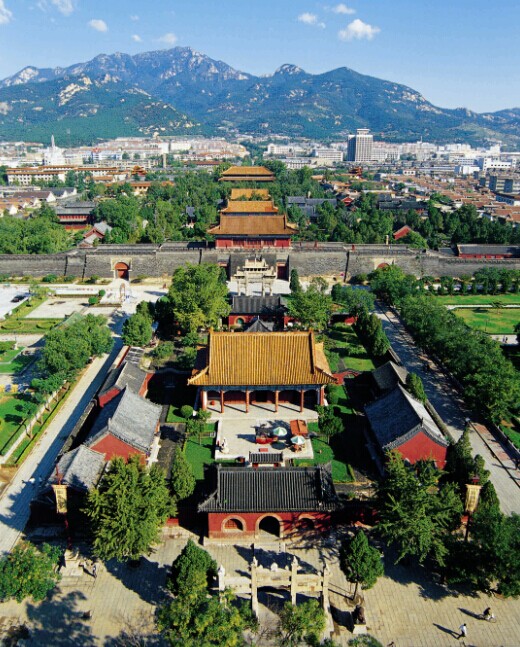Dai Temple


Dai Temple was built in the Han Dynasty. It was magnificent with majestic halls during the Tang dynasty. In Song Zhenzong's worship, it was a building with the Hall of Heavenly Blessings. It takes the architectural style of imperial palace, peripheral ring of 1500 meters; there are more than 150 rooms in the ancient temple building. It is one the four Chinese ancient buildings with the Imperial Palace in Beijing, Chengde Mountain Resort, and the Three Memorial Edifices of Confucius in Qufu.
Stepping into the temple, as if through the ancient and modern, towering old trees, green trees lined, red walls and yellow tiles, solemnly quaint, palaces, it seems like the emperor Qian Long wearing a yellow robe, is throwing his weight around in calm.

Dai temple is the source of faith of Mount Tai. As early as the Western Han Dynasty, Tai'an was the "Mount Tai Temple". It is the predecessor of the present Mount Tai temple's according to test. In the northern and Southern dynasties, it was developed into the up-middle-lower three temples, and was built with big steps in Tang and Song Dynasties, and later rebuilt in Jin, Yuan, Ming, and Qing Dynasties, to gradually form the pattern of magnificent halls.
The main attractions are Dai Temple square, Yaocan Pavilion, Zhengyang door, pagoda tree courtyard of Tang dynasty, Tian kuang Hall, Han dynasty cypress courtyard, copper Pavilion tower and Dong Yu seat hotel.
Among them, the Hall of Heavenly Blessings is the main building of the Dai Temple, at Dongyue shrine. The hall is dedicated to the Mount Tai God of Dongyue with solemn face in solemn atmosphere. The statue is 4.4 meters high, head crown, dressed in Dragon robe, holding a plate, like a God. It is said in Mount Tai folklore that the God is Huang Feihu. In "Fengshen Kingdoms", According to the arrangement of primus, Jiang Ziya rewarded Huang Feihu as "Dongyue Mount Tai Tianqi emperor" for Huang Feihu's repeated contribution and gave him the power on the world's weal and woe.
Tian kuang hall has the architectural style of Zhong Yan Xie Shan, painted brackets, painted tile covered roof, 8 Red columns under the eaves, which are large-scale and magnificent. With Taihe Dian Hall of the Imperial Palace in Beijing, Qufu Dacheng hall, they are known collectively as the "three ancient Chinese palaces".
Noticeable here is a huge "Mount Tai God Qi Bi Hui Luan picture" painted on the north, East and West walls in Tiankuang Hall. The wall painting is 3 meters high and 62 meters long. "Qi" is starting, "Bi" is to keep the street clear and quiet, or stop to watch, "Luan" means to return. It describes the mighty spectacular of God of Mount Tai. The eastern part is tour of inspection and the western part is returning. The whole picture has 675 persons with auspicious beast, stone forest, palace and a bridge, the density and interaction is in order with different poses and expressions vividly displayed. It is not just a landscape of Mount Tai, but also one of the mural masterpieces of China Taoism.
Recommended reason:
The Dai Temple, formerly known as the "Dongyue Temple", also known as Tai Temple, the main worship "Dongyue God of Mount Tai", is the place to make sacrificial ceremonies and living for the ancient emperors. Dai Temple is the most concentrated place of cultural relics in Mount Tai. Kept here are a superb collection of beautiful things of the ancient imperial worship, God's sacrificial offerings, and arts and crafts. There are cultural relics and historical relic flashes of Chinese civilization unearthed in Mount Tai. Other valuables include 184 pieces of Ancient inscriptions and 48 Han-dynasty Stone Carvings, which became the third stone tablets in China after Xi'an and Qufu.
Tickets: 30 yuan for adult tickets; 15 yuan for students.
Open time: 8:00-17:30 during September 1st to October 31st; 8:00-17:00 during November 1st to February 28th.
Traffic: take bus 3, 4, 6, k33 to the Dai-Temple Station; take bus K1, 8 to “Tongtianfang” station; take bus k36 to Dai temple (Taikang Life) station.
Website: http://www.daimiao.cn/
MOST POPULAR
- 1 China to continue opening up its mega-market to world: premier
- 2 Policies concerning expats, foreign enterprises in November 2025
- 3 China to enhance convenience for inbound tourism: minister
- 4 Departure tax refund applications surge 285% as inbound tourism rebounds
- 5 China's foreign trade up 3.6% in first 11 months of 2025







